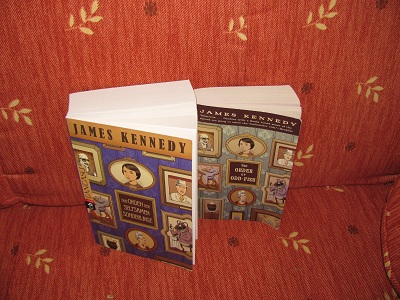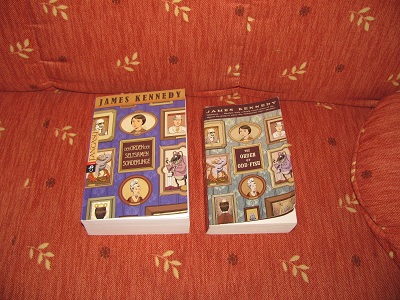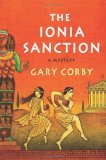 It’s Sonderling Sunday again! “Nerd Sonntag,” where I play with language by looking at German translations of bizarre English words and phrases as found in James Kennedy’s The Order of Odd-Fish.
It’s Sonderling Sunday again! “Nerd Sonntag,” where I play with language by looking at German translations of bizarre English words and phrases as found in James Kennedy’s The Order of Odd-Fish.
Last time, I left off on page 16 of The Order of Odd-Fish, and page 25 of Der Orden der Seltsamen Sonderlinge.
Let me begin with the first paragraph of this next section:
Jo’s bathroom, like everything else at Lily Larouche’s palace, was a gilded wreck of red and gold marble, kaleidoscopic mirrors, and frenzied geometric mosaics, dimly lit by dozens of spicy smoking candles sprouting from a brass chandelier so mammoth and ornate it seemed like a fiery flying city. Jo lay soaking in the ivory bathtub, the silence broken only by the distant chatter of the television, and thought about Aunt Lily.
(Side note: You can see why this book is such a rich source to look at for interesting words to translate! I mean, what phrase book would ever think to translate “kaleidoscopic” or “frenzied geometric mosaics”? No wonder these German words are new to me!)
Here’s the same paragraph in Der Orden der Seltsamen Sonderlinge:
Jos Badezimmer war, wie alles andere in Lily Larouches Palast auch, ein vergoldetes Wrack aus rotem und goldenem Marmor, kaleidoskopartigen Spiegeln und verrückten geometrischen Mosaiken. Dutzende Duftkerzen tauchten alles in ein dämmriges Licht. Sie brannten in einem Messinglüster, der so riesig und so von Ornamenten überladen war, dass er wie eine gewaltige fliegende Stadt wirkte. Jo lag in der Badewanne aus Elfenbein. Die stille wurde nur von dem fernen Geplärr des Fernsehgerätes und ihren Gedanken an Tante Lily gestört.
Note: I’m going to use Google translate to get at more literal translations of the German, to get at the roots of what’s being communicated here.
Well, the ones I was looking forward to aren’t quite as interesting as some others. But here we go:
“kaleidoscopic mirrors” = kaleidoskopartigen Spiegeln
“frenzied geometric mosaics” = verrückten geometrischen Mosaiken (I’ve also seen verrückten used to translate “crazy.”)
This one has a lilt to it:
“dozens of spicy candles” = Dutzende Duftkerzen
The sentence itself, Dutzende Duftkerzen tauchten alles in ein dämmriges Licht, translates more literally into: “Dozens of scented candles appeared in a dusky light.”
“brass chandelier” = Messinglüster (“brass shine”)
“ivory” = Elfenbein (“elven bone”? Or is this related to Elefant?)
“distant chatter” = fernen Geplärr (“far bawling”)
My favorite from that paragraph is Dutzende Duftkerzen. I always like the translations that turn out more mellifluous than the original. (I still like saying gefährlichen Gefährtin to myself. Or Papperlapapp!)
I won’t do the full paragraphs for this next part, but here are some fun words:
“handyman” = Faktotum (I had no idea that was a German word.)
“shuffled” = schlurfte (Now that is fun to say! I’m going to schlurfe around my house today.)
“pink foam” = rosafarbenem Schaum
“squirreled away” = eingesperrt (Google: “incarcerated”)
“prowling” = schleichen (“sneak”)
“practiced” = übte
“curiosity” = Neugier (“new greed” — love that! “Curiosity” is a greed for the new!)
“secretly” = insgeheim (“in mystery”)
This one just sounds good:
“what the world was really like” = wie die Welt wirklich war
“stunt” = Art von Nummer (“type of number”)
“frustrated” = frustriert
Here’s another section, so I’ll give the opening paragraph again:
Es war fast Zeit für Jo, zur Arbeit zu gehen. Sie stieg aus ihrem Bad, trocknete sich ab und zog ihre Kellnerinnen-Uniform an: ein pinkfarbenes kratziges Polyesterkleid, das ihr nicht wirklich passte. Dann ging sie nach oben und sah nach Oberst Korsakov.
In English:
It was almost time for Jo to go to work. She got out of her bath, dried off, and changed into her waitress uniform — a pink, itchy polyester dress that didn’t really fit — and went to check on Colonel Korsakov.
Wait a minute! Before “pink” was rosa, and now it’s just pink? Hmm. Maybe German is giving us different shades of pink?
I love “itchy” = kratziges Doesn’t that just sound itchy?
Reading on:
“knocked” = klopfte
“Jo hesitated, then cautiously tiptoed into the darkened room.” = Jo zögerte, öffnete die Tür und schlich auf Zehenspitzen behutsam in den dunklen Raum.
Of course, that gives us:
“hesitated” = zögerte
“tiptoed” = schlich auf Zehenspitzen (“crept on pointed toes”)
“cautiously” = behutsam
Oo, this next paragraph is so lovely in English, it demands mentioning in its entirety:
Korsakov lay on the sagging bed, snoring and snorting, his stomach heaving under his pajamas like an unsteady mountain of jelly. Jo stared in a kind of awe. Korsakov was somehow even more colossal than she remembered — like an exuberantly portly walrus.
Auf Deutsch:
Der Russe lag auf dem Bett, dessen Matratze durchhing, und schnarchte aus Leibeskräften. Sein Bauch hob sich in dem Pyjama wie ein wabbelnder Berg aus Gelatine. Jo starrte ihn fast ehrfürchtig an. Korsakov war noch kolossaler, als sie ihn in Erinnerung hatte, er schaute aus wie ein ausgesprochen korpulentes Walross.
Some more good ones from that:
“sagging” = durchhing (“hanging through”)
This one’s better in English: “snoring and snorting” = schnarchte aus Leibeskräften (“snored with all his might”)
But this makes up for it: “an unsteady mountain of jelly” = wabbelnder Berg aus Gelatine (I don’t know about you, but I really like wabbelnder.)
“awe” = ehrfürchtig (“glory fear” I like that!)
And of course, we can’t let this one go by:
“an exuberantly portly walrus” = ausgesprochen korpulentes Walross (ausgesprochen by itself I would have thought was “outspoken,” but Google translates it “pronounced.” That works, though we don’t really have “exuberance.” But what can you do? Is “exuberantly portly” such a bizarre concept that it can’t be translated? Really?)
Going on, some more choice translations:
“wadded up” = zusammengeknüllten (“together crumpled”)
“gurgling chimes” = glucksende Glöckchen (“clucking little bells”! Again, the German is more mellifluous.)
Ah! This time they do a little better with the onomatopoeia:
“murmuring beeps and bloops” = murmelndes Piepen und Ploppen
“crank” = Kurbel
Here’s another one much more fun to say in German:
“The dirty rag!” = Dieses schmutzige Schmierblatt!
“Shameless!” = Unverschämtheit!
Okay, I’ve been waiting for the introduction of Sefino. Here’s the section in German:
Eine gigantische Kakerlake hatten den Raum betreten. Sie war mindestens einen Meter fünfzig gro?, trug einen violetten Samtanzug, darunter ein Seidenhemd, eine Krawatte und einen Bowler auf dem Kopf. Im Knopfloch steckte eine grüne Nelke. Die Kakerlake hielt mit vier Armen eine Zeitung, die sie durch ein Monokel studierte. Jo wich zurück, aber das Insekt nahm sie kaum war.
In English:
A giant cockroach had walked into the room, three feet tall, wearing a purple velvet suit with a silk shirt, cravat, and bowler hat. A green carnation was fixed in its buttonhole. The cockroach clutched a newspaper with four arms, reading it through a monocle. Jo backed away, but the insect barely acknowledged her.
Don’t miss this one: “giant cockroach” = gigantische Kakerlake (May I never ever have a reason to know that!)
I think this is funny. The translator is very literal with the translation of “three feet tall,” using einen Meter fünfzig gro?, using “one meter, fifty centimeters” instead of just saying about a meter. And wait a minute, a meter is slightly more than three feet, not fifty centimeters less. What’s up with that?
“buttonhole” = Knopfloch
More fun words:
“Libel!” = Verleumdung!
“Outrage!” = Frechheit! (“cheekiness”)
“Shootings, canings, and bludgeonings from the sky enlivened the evening” = Schie?ereien, Züchtigungen und Prügel aus heiterem Himmel belebten den Abend
Oh, here’s a chandelier again:
“a frightful glass chandelier that, I maintain, was improperly installed” = ein furchterregender Kristalllüster, der, worauf ich bestehe, nicht sachgemä? installiert war (Don’t you love a language where the proper spelling of a word can involve three Ls in a row?)
“Chatterbox” = Plaudertasche
“Will I never be rid of these rumor-mongering muckrakers?” = Werde ich diesen im Schlamm wühlenden Dreckspatzen denn niemals entkommen? (“Will I never escape burrowing in the mud with these dirt sparrows?”)
“intestines” = Dickdarm (“large intestine” Don’t ask!)
Oh, Sefino’s dictation must be quoted:
Dear Eldritch Snitch. I slap you with the satin glove of righteous wrath! From what noxious nest of nattering nincompoopery do you release your rancorous roosters of rumor . . .
This translates to:
Liebe Schauerliche Petze! Ich ohrfeige Euch mit dem Seidenhandschuh rechtschaffenen Zorns! Aus welchem verderbten Nest schwatzhafter Einfaltspinsel Ihr Eure boshaften, aufgeblasenen Gerüchte . . .
Some notable translations:
“Eldritch Snitch” = Schauerliche Petze (“gruesome sneak”)
“I slap you with the satin glove of righteous wrath!” = Ich ohrfeige Euch mit dem Seidenhandschuh rectschaffenen Zorns! (“I box you on the ears with the silk hand shoe of righteous scorn!”)
Alas! The alliteration of the last sentence seems untranslatable. We do have:
“noxious” = verderbten
“nattering” = schwatzhafter (“chatty”)
“nincompoopery” = Einfaltspinsel (“simpleton”)
“rancorous roosters of rumor” = boshaften, aufgeblasenen Gerüchte (“evil overblown rumors”)
Going on:
“narrowed his eyes” = kniff die Augen zusammen (“pinched his eyes together”)
“Jo had just about had enough.” = Jetzt hatte Jo die Nase endgültig voll. (“Now Jo’s nose was finally full.”) Love it!
“tied up” = gefesselt
“upsidedown” = kopfüber (head over)
“You’re never so happy as when you have a nice fresh bullet lodged in your belly.” = Sie sind nur dann glücklich, wenn Sie eine hübsche neue Kugel in Ihrem Wanst haben.
“You deliberately enrage armed lunatics!” = Sie ermutigen diese bewaffeneten Verrückten doch absichtlich!
“Boiling Brezhnevs!” = Brodelnde Breschnews!
Not as good in German: “We meander, we drift.” = Wir folgen verschlungenen Pfaden, wir treiben umher. (“We follow tortuous paths, we drive around.”)
“I once gallivanted” = Einmal habe ich mich sogar herumgetrieben.
“powdered wigs” = gepuderter Perücken (Another one more fun to say in German.)
“Danish” = Kopenhagener (Same idea, there. It’s talking about the pastry.)
“sighed loudly” = seufzte vernehmlich
“in a small voice” = klang kläglich (“rang miserably”) Nice and alliterative.
“coughed” = räusperte
“pile” = Haufen
“doubt” = bezweifle (This has the word for “two,” zwei, in it. Like “doubt” comes from “double”? Wavering between two opinions?)
Okay, I got through the rest of Chapter Two! Perhaps I can make progress after all…. Now that I know more of the words, I’m pausing to translate only the most interesting. But they still haven’t gotten to Eldritch City, so I know there will be many more interesting phrases to come! And I hope I’ve intrigued some readers into reading the inimitable book The Order of Odd-Fish in order to find out the context of some of these phrases! Enjoy!
 It’s Sonderling Sunday again! Yes, it’s late, but I have time to get in a little bit of language fun before the day’s over.
It’s Sonderling Sunday again! Yes, it’s late, but I have time to get in a little bit of language fun before the day’s over.




